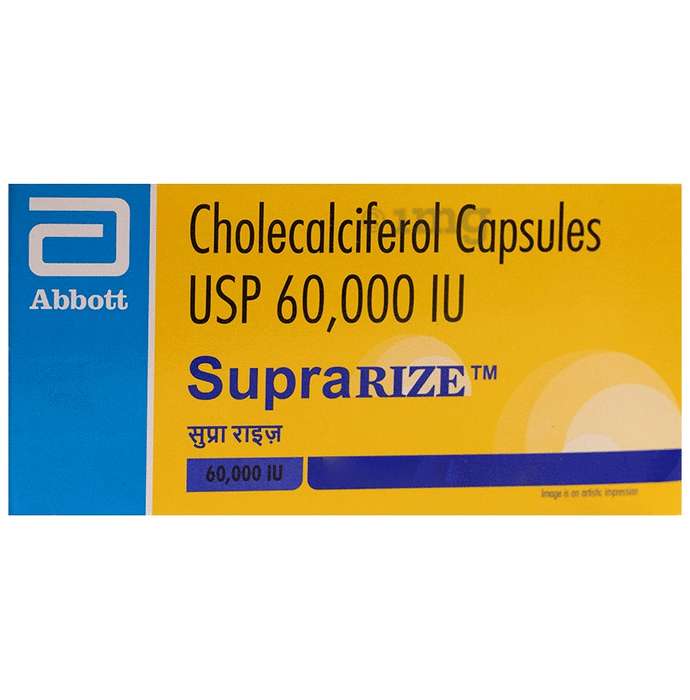



Abbott Supra Rize Cholecalciferol USP 60,000IU Capsule
Product highlights
- Used to treat vitamin D deficiency
- Helps in the absorption of calcium
- Plays a crucial role in bone health
MRP
₹96Inclusive of all taxes
of4 capsules
DISCONTINUED
We do not facilitate sale of this product at present
Information about Abbott Supra Rize Cholecalciferol USP 60,000IU Capsule
Abbott Supra Rize Cholecalciferol USP 60,000IU Capsule provides the goodness of vitamin D, a fat-soluble vitamin that plays an important role in maintaining calcium balance and bone health.
The majority of patients with vitamin D deficiency are asymptomatic. However, even mild chronic vitamin D deficiency can lead to chronic hypocalcemia and hyperparathyroidism which can contribute risk of osteoporosis, falls and fractures especially in the elderly population.
Patients with severe vitamin D deficiency can experience symptoms associated with secondary hyperparathyroidism including bone pain, body, fatigue, muscle twitching (fasciculations), and weakness.
Fragility fractures may result from chronic vitamin D deficiency leading to osteoporosis.
However, subclinical vitamin D deficiency is still widely prevalent in both developed and developing countries. Subclinical vitamin-D deficiency is associated with osteoporosis, increased risk of falls and fragility fractures.
Key Ingredients:
Cholecalciferol IP (Vitamin D3): 60,000 IU (International units)
Key Benefits:
Directions For Use:
Take Supra Rize as directed by your physician.
Safety Information:
FAQs Related to Supra Rize Capsule:
What is Supra Rize?
SupraRize is a set of 4 softules with 60000 IU of Vitamin D3 each. It comes in an amber colour packing
What is the best time to take SupraRize?
These capsules are best absorbed when taken orally after a meal.
Ideally, Vitamin D3 supplements should be taken along with the largest meal of the day. Please consult your treating physician for further treatment and advice.
What are the signs and symptoms of Vitamin D3 deficiency?
The majority of patients with vitamin D deficiency are asymptomatic. However, even mild chronic vitamin D deficiency can lead to chronic hypocalcemia and hyperparathyroidism which can contribute risk of osteoporosis, falls and fractures, especially in the elderly population.
Patients with chronic and severe vitamin D deficiency can experience symptoms including bone pain, body, fatigue, muscle twitching (fasciculations), and weakness. Fragility fractures may result from chronic vitamin D deficiency leading to osteoporosis
What are the signs and symptoms of Vitamin D 3 overdosage?
Hypervitaminosis of vitamin D is a rarely reported condition. However, overdosage may result in anorexia, thirst, nausea, vomiting, constipation, abdominal pain, muscle weakness, fatigue, mental disturbances, polydipsia, polyuria, bone pain, nephrocalcinosis, renal calculi and, in severe cases, cardiac arrhythmias.
Extreme hypercalcemia may result in coma and death. Persistently high calcium levels may lead to irreversible renal damage and soft tissue calcification.
What are the side effects of Vitamin D3?
Vitamin D at normal doses usually has no side effects. An allergic/hypersensitivity reaction to this drug is rare. However, please consult your treating physician in case you encounter this.
Too much vitamin D can cause harmful high calcium levels. Some of the associated symptoms are as follows: nausea/vomiting, constipation, loss of appetite, increased thirst, increased urination, mental/mood changes, and unusual tiredness.
The majority of patients with vitamin D deficiency are asymptomatic. However, even mild chronic vitamin D deficiency can lead to chronic hypocalcemia and hyperparathyroidism which can contribute risk of osteoporosis, falls and fractures especially in the elderly population.
Patients with severe vitamin D deficiency can experience symptoms associated with secondary hyperparathyroidism including bone pain, body, fatigue, muscle twitching (fasciculations), and weakness.
Fragility fractures may result from chronic vitamin D deficiency leading to osteoporosis.
However, subclinical vitamin D deficiency is still widely prevalent in both developed and developing countries. Subclinical vitamin-D deficiency is associated with osteoporosis, increased risk of falls and fragility fractures.
Key Ingredients:
Cholecalciferol IP (Vitamin D3): 60,000 IU (International units)
Key Benefits:
- It is used to treat vitamin D deficiency and thereby help in bone problems and to aid the growth and development of bones
- The capsule contains Vitamin D3, a fat-soluble vitamin that helps the gut to absorb calcium from food and the body to maintain adequate levels of two minerals essential for bone health, calcium and phosphorus
- Vitamin D is known to help the body absorb calcium, and it plays a role in bone health
- Vitamin D may increase muscle strength, thereby preventing falls
- Many studies have shown an association between low vitamin D concentrations and an increased risk of fractures and falls in older adults. Vitamin D has beneficial effects on protective immunity
- Therapeutic dose of vitamin D showed that vitamin D administration resulted in a statistically significant (42%) decrease in the incidence of infections
Directions For Use:
Take Supra Rize as directed by your physician.
Safety Information:
- Read the label carefully before use
- Store in a cool and dry place away from direct sunlight
- Keep out of reach of the children
- Use under medical supervision
FAQs Related to Supra Rize Capsule:
What is Supra Rize?
SupraRize is a set of 4 softules with 60000 IU of Vitamin D3 each. It comes in an amber colour packing
What is the best time to take SupraRize?
These capsules are best absorbed when taken orally after a meal.
Ideally, Vitamin D3 supplements should be taken along with the largest meal of the day. Please consult your treating physician for further treatment and advice.
What are the signs and symptoms of Vitamin D3 deficiency?
The majority of patients with vitamin D deficiency are asymptomatic. However, even mild chronic vitamin D deficiency can lead to chronic hypocalcemia and hyperparathyroidism which can contribute risk of osteoporosis, falls and fractures, especially in the elderly population.
Patients with chronic and severe vitamin D deficiency can experience symptoms including bone pain, body, fatigue, muscle twitching (fasciculations), and weakness. Fragility fractures may result from chronic vitamin D deficiency leading to osteoporosis
What are the signs and symptoms of Vitamin D 3 overdosage?
Hypervitaminosis of vitamin D is a rarely reported condition. However, overdosage may result in anorexia, thirst, nausea, vomiting, constipation, abdominal pain, muscle weakness, fatigue, mental disturbances, polydipsia, polyuria, bone pain, nephrocalcinosis, renal calculi and, in severe cases, cardiac arrhythmias.
Extreme hypercalcemia may result in coma and death. Persistently high calcium levels may lead to irreversible renal damage and soft tissue calcification.
What are the side effects of Vitamin D3?
Vitamin D at normal doses usually has no side effects. An allergic/hypersensitivity reaction to this drug is rare. However, please consult your treating physician in case you encounter this.
Too much vitamin D can cause harmful high calcium levels. Some of the associated symptoms are as follows: nausea/vomiting, constipation, loss of appetite, increased thirst, increased urination, mental/mood changes, and unusual tiredness.
Country of origin: India
 Authentic Products
Authentic Products Great Savings
Great Savings Home Delivery
Home Delivery





